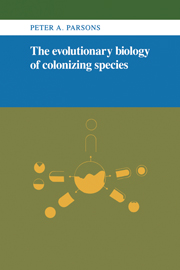Book contents
- Frontmatter
- Contents
- Preface
- 1 Introduction: Colonists and habitats
- 2 Genetics and ecology
- 3 Physical conditions, resources, and ecological phenotypes
- 4 Variability in natural populations
- 5 Genetic variability, ecological phenotypes, and stressful environments
- 6 Colonizing phenotypes and genotypes
- 7 Behavioral variability in natural populations
- 8 Habitat selection
- 9 The ecobehavioral phenotype: generalists and specialists
- 10 The ecobehavioral phenotype: biological control and domestication
- 11 Parasites and plants
- 12 Discussion and conclusions
- Appendix The study of quantitative traits
- References
- Index
9 - The ecobehavioral phenotype: generalists and specialists
Published online by Cambridge University Press: 15 September 2009
- Frontmatter
- Contents
- Preface
- 1 Introduction: Colonists and habitats
- 2 Genetics and ecology
- 3 Physical conditions, resources, and ecological phenotypes
- 4 Variability in natural populations
- 5 Genetic variability, ecological phenotypes, and stressful environments
- 6 Colonizing phenotypes and genotypes
- 7 Behavioral variability in natural populations
- 8 Habitat selection
- 9 The ecobehavioral phenotype: generalists and specialists
- 10 The ecobehavioral phenotype: biological control and domestication
- 11 Parasites and plants
- 12 Discussion and conclusions
- Appendix The study of quantitative traits
- References
- Index
Summary
In order to understand the many curious anomalies we meet with in studying the distribution of animals and plants, and to be able to explain how it is that some species and genera have been able to spread widely over the globe, while others are confined to one hemisphere, to one continent, or a single island, we must make some inquiry into the different powers of dispersal of animals and plants, into the nature of the barriers that limit their migrations, and into the character of the geological or climatal changes which have favoured or checked such migrations.
[Wallace, 1880:70]The ecobehavioral phenotype
On constructing the phylogeny of a group of animals, such as ducks and pigeons, based on behavioral traits, that phylogeny is extremely similar to an independently assigned one based upon strictly morphological traits. The interpretation of this parallelism is that both sets of characters are the product of the same genotype, representing a closed genetic program in the sense of Mayr (1974), who gives other examples including gulls and storks. An excellent insect example is a survey of 101 species of Drosophila (Spieth, 1952). Generally the evolution of mating behavior parallels the morphological evolution of the group. In addition, Spieth concludes that the divergence of mating behavior between species occurs first at the physiological and behavioral levels and visually observable morphological differences arise much later. In a later study, Brown (1965) found a similar high association of morphological and behavioral traits for the obscura group of species.
- Type
- Chapter
- Information
- The Evolutionary Biology of Colonizing Species , pp. 150 - 174Publisher: Cambridge University PressPrint publication year: 1983



